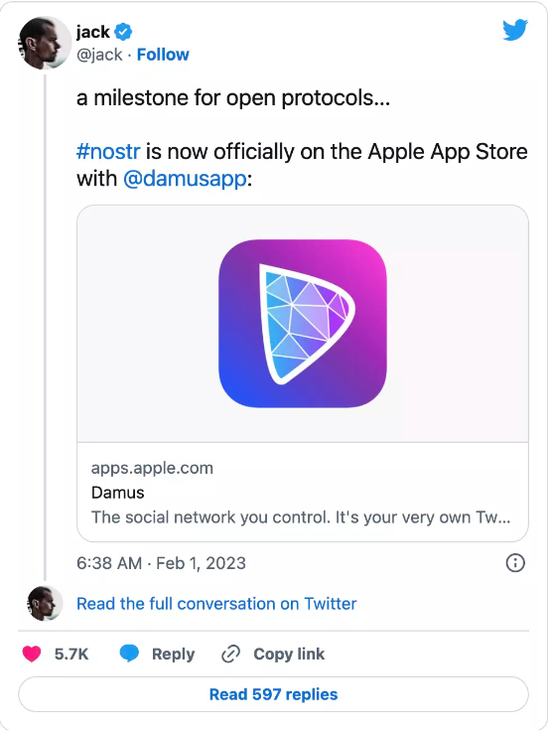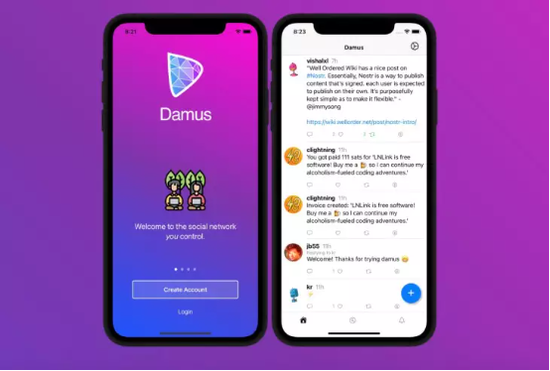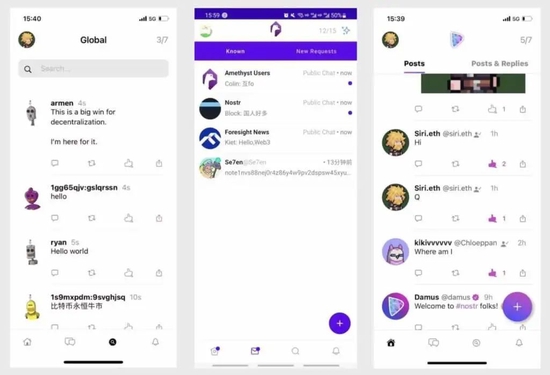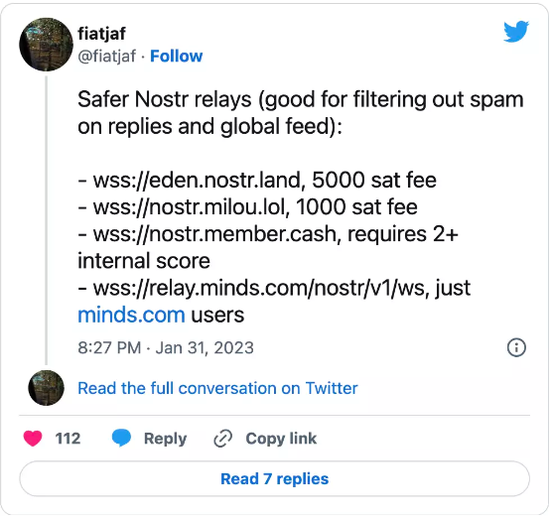
Author | Liu Yan, Nuka-Cola
Source | AI Frontline
Damus, another decentralized social application challenging Twitter, has officially landed on the App Store.
Damus is available on the Apple App Store
On February 1, former Twitter CEO Jack Dorsey tweeted that Damus, a social product based on the decentralized social media protocol Nostr, has been launched on the Apple App Store and anyone can download it.

Jack Dorsey disclosed his Nostr public key in his personal social media signature. He also applauded the launch of Damus in the Apple App Store.

However, the process of Damus on the Apple App Store has not been smooth. In fact, the launch time could have been advanced a few weeks, but Damus was repeatedly “difficult” by Apple.
The decentralized nature of Damus caused some trouble during the initial app review process. Judging from the denial of information, it is clear that Apple is still using the guidelines of traditional social networks such as Twitter to censor Damus, and does not take into account the characteristics of its open information access protocol. Apple has been requiring the app to follow the same rules as other social networks, such as giving users the option to flag objectionable content, while posting a clear abuse restraint policy.
The official Damus account had previously tweeted that the app had been rejected from the App Store multiple times, despite addressing the issues raised by Apple.
But yesterday, the situation took a major turn and the Damus app was finally approved. Jack Dorsey excitedly claimed that the debut of Damus on the App Store is “a milestone in the open protocol”, which means that a new generation of social tools that are not manipulated by technology giants has begun to land…
As soon as Nostr was launched, it quickly aroused heated discussions in the encryption community, and many community members shared their personal Nostr public keys on social media and within the community. Today, Nostr swiped the screen of Moments in China.
As of February 1, Damus’ Twitter account had 17,700 followers. Damus is now available on GitHub (https://ift.tt/8ktdPcF) and App Store (https://ift.tt/gNs5ax3), currently in the US iOS Social Networking category Ranked #10 in the app. Damus also entered the overall app popularity list in four other countries: Hong Kong (No. 9), Vanuatu (No. 90), Singapore (No. 91) and Macau (No. 92).
The look and feel of Damus is very similar to the iOS Twitter app. But the biggest difference between it and other social networking applications lies in the scope of private information usage.
According to Apple’s requirements, Twitter’s official application admits that it will collect users’ purchase records, contact information, browsing record usage data, location, user content, identity, search history, diagnosis and other data.
In contrast, Damus’ description is rather succinct: No data collected. The developer does not collect any data through this app.
Media commentators have described Nostr as an alternative to Twitter, which was acquired by Musk last year. Some members of the encryption community believe that Nostr will become a “Twitter killer.”
Last year, Twitter co-founder Jack Dorsey threw 14 bitcoins (approximately $245,000 at the time) to fund the development of Nostr, an open decentralized social network protocol based on encrypted key pairs.
According to Nostr’s official website, Damus is just one of several Nostr projects under development. There’s also Anigma, a Telegram-like chat app; Nostros, a mobile client; and Jester, a chess app.
The former Twitter executive has been busy building Bluesky, another decentralized social network powered by the new AT protocol, and plans to release a similar client application in the future.
How to register, explain the functions and experience in detail
Damus products will be open for internal testing in April 2022, and are currently open for download on Apple mobile phones, iPads, and Google stores. Users can directly create an account, and when creating an account, they only need to enter the username they are used to, no phone number, email, or name is required. and other personal information.
After the account is created, the system will pop up the public key (starting with npub, corresponding to the user’s “ID”, which can be shared with friends to follow, or you can set the user name yourself), click the copy button next to the public key, and then the system will automatically pop up the private key (begins with nsec, which corresponds to the user’s highest control over the account and needs to be saved by himself), continue to click the copy button next to the private key to enter the Damus product interface.
Similar to Twitter, the ‘+’ at the bottom right of the Damus homepage is the entry for posting. Similar to most current social networks, Damus has also set up a hashtag function, and you can add a topic or topic word after # when publishing a post. However, if you want to add a picture when posting, you can only publish it by converting the picture into a link first.

At the bottom of the Damus homepage, there are four buttons: Moments, Private Messages and New Friend Requests, Global and Notifications. The Moments timeline column can receive the dynamics of the users you follow. In Global, you can browse the dynamics of all Damus users in real time, and also support direct search for other users name or public key address, but only supports searching for user names or public keys, not specific content. In addition, Damus also supports user reporting and blocking functions, which can report scam, illegal, impersonation and other accounts.
Overall, the design of the Damus page is simple and elegant, but many functions are rough and incomplete. For example, posting does not support style editing, cannot be deleted after posting, likes or retweets cannot be undone, and pictures need to be converted into links before they can be published. In addition, advanced requirements such as trends and filters need to be added urgently. It is worth mentioning that Amethyst also has a group chat function, where you can make friends with similar interests, and it is also conducive to forming a strong social network effect.
The website version of snort.social has the option to delete text, but there is a bug, and it will still be displayed after refreshing after deletion. There is also user feedback that the downloaded Damus mobile version is in German or Spanish, and there is no option to change the language. In addition, Damus, Amethyst and the webpage snort.social can also log in with a private key address, and personal publishing dynamics will also be synchronized.
Decentralized Social Media Protocol
What is Nostr?
Nostr is an open protocol that aims to create a censorship-resistant global social network, which is not a single website, but a network of thousands of users who can post to each other’s relay servers , the servers can seamlessly interact with each other.
In fact, the basic definition of Nostr’s technology is not new: a non-peer-to-peer decentralized network based on encryption key pairs.
The full name of Nostr also reveals more information: “Notes and Other Stuff Transmitted by Relays”, that is, notes and other materials transmitted by relays. Essentially, it allows anyone to create their own social networking platform and share it with whoever you choose.
You don’t need any server or technical knowledge, and you don’t even need a Nostr account, because the concept of an account does not exist in Nostr. Nostr is not a platform, but a protocol. There is no Nostr company, no CEO or board of directors, just developers contributing to the open source protocol. As long as you have the public key, it can identify you.
Right now, Nostr’s main use case is to create a Twitter-like social networking service, but its promise goes far beyond that. Nostr is to social networking what HTTP is to messaging or IMAP is to communication. It is a low-level protocol on which you can build any project you need.
Nostr emphasizes its censorship-free regime: no watchdog controls what is allowed and what is not. Nostr is based on relay, and the Damus application using this protocol only provides recommended content, and more new messages pop up in subsequent use.
Some paid relays claim to be used to filter spam, but this part of the business may soon disappear. Home server products like Start9 even use Nostr relays in their development. Nostr also supports end-to-end encrypted private messaging, again without relying on any servers.
Whether the Nostr protocol will succeed remains to be seen, but while major social networks such as Twitter and Facebook have caused huge controversy, it certainly brings us new and quite interesting options.
integrated with bitcoin
Lightning Network
Nostr is popular among Bitcoin users in part because most of its implementations support payments via Bitcoin’s Lightning Network.
Bitcoin integration is also an important part of the Damus experience. Nostr applications such as Damus can access Bitcoin’s Lightning Network, thereby opening up the creative tipping function. For example, users can use Bitcoin to reward friends’ posts, with the help of Bitcoin’s Lightning Network. Through apps like Strike, Damus users can send $0.10 to authors to support a quality blog post, podcast, or post they’ve created.
Visa cards don’t support small transfers like $0.10, but Bitcoin’s L2 Lightning Network allows people to send money to others around the world for almost free, all without a bank. Some Nostr supporters mentioned that the currency carrier on Twitter is traffic, while Nostr uses Sats (the abbreviation of Satoshi Nakamoto). 1 Bitcoin equals 100 million Sats.
In terms of Profile settings, Damus allows you to change your avatar and background picture (via picture link), add your own website and profile information, and also supports setting a Bitcoin lightning tip address, which is also a core highlight of Damus.
Currently, the lightning tip payment platforms supported by Damus include Strike, Cash App, Muun, Blue Wallet, Wallet of Satoshi, Zebedee, Zeus LN, LNLink, Phoenix, Breez, Bitcoin Beach, Blixt Wallet, River.
Six advantages of Damus
Damus positions itself as ‘the social network you can control’. According to the description on Damus official website, Damus has the following six advantages:
-
User Control: Built on the open network protocol Nostr, no platform can ban or censor, users can control their own data and voice;
-
Message encryption: private messaging with end-to-end encryption;
-
No registration required: no phone number, email or name are required to create an account;
-
No server required: messages are distributed through decentralized relays, without running any infrastructure and without a single point of failure;
-
Programmable design: Allows for easy integration of robots, helping users automate their lives or businesses. Damus will also notify you when your server goes down.
-
Tip: Support using Bitcoin and Lightning Network to reward friends’ posts and stack sats.
Another Alternative to Twitter
The new app is the latest in a slew of alternatives to Twitter that have sprung up since Musk took over.
Fearing that Musk would roughly interfere with the rules of the Twitter community, people turned to original applications such as Tumblr, and even actively tried decentralized social services such as Mastodon. Startups such as T2 and Spill, which are still in the seed funding stage, are also developing their own alternatives to Twitter.
But Damus is not a venture-backed start-up. Instead, they hope to devise new experiments for decentralized social networks. The so-called decentralized social network is to abandon the basic system of Facebook or Twitter, which uses a central organization to determine the network publishing content/user participation rights, and instead create a completely open social environment.
Damus writes on the homepage, “Everything is in your control… No need to worry about any bans or censorship, your data is in control of you.” The website also specifically promotes message encryption-Twitter does not have this feature, and many users The importance of encryption was only realized after Musk took over.
Backed by Nostr, Damus also doesn’t require registration via phone number, email or name, unlike Mastodon. In Mastodon, user accounts are attached to a particular server, and administrators have some control over who is registered on that server. In other words, once the Mastodon server currently used by the user has a problem (such as downtime), it may affect the user’s normal access to the social network. And if there is a sudden failure or a permanent offline, data may be lost.
On Damus, messages are distributed through decentralized relays – the full name of Nostr is “Notes and Other Stuff Transmitted by Relays”, that is, notes and other materials transmitted by relays. It doesn’t involve a federated network of servers like Mastodon does, but some Nostr relays are said to filter spam better.

Safer Nostr relay (filters spam from replies and global feeds)
Also, unlike Twitter, posts on Damus can be longer than 280 characters.
According to foreign media reports, Nostr’s early testers include Vitalik Buterin, the co-founder of Ethereum, Edward Snowden, who shocked the world because of his decryption, and Cynthia Lummis, a U.S. Senator who supports cryptocurrencies.
In contrast, Mastodon, the main escape target for Twitter users in the Musk era, uses an older protocol called ActivityPub. Bluesky and Mastodon will not be able to interact unless one chooses to integrate with the other’s protocol, or devise some other transitional system.
New applications based on the Nostr protocol also won’t be able to interoperate with Mastodon or Bluesky, says Damus developer William Casarin, but in the future “maybe there will be a bridge between those protocols.”
The advent of Damus has added another member to the open protocol ecosystem. Now it seems that the competition for Twitter alternatives is not only a confrontation between Silicon Valley startups, but also a competition for the dominance of the underlying technology of the future social network.
However, Damus and Nostr as an infrastructure are still in their early stages, and the combination with Bitcoin and Web3 gives us a lot of room for imagination. Whether Jack Dorsey’s decentralized social vision can be realized on a large scale, let us wait and see.

(Disclaimer: This article only represents the author’s point of view, not the position of Sina.com.)
This article is reproduced from: https://finance.sina.com.cn/tech/csj/2023-02-02/doc-imyehtzn9879473.shtml
This site is only for collection, and the copyright belongs to the original author.